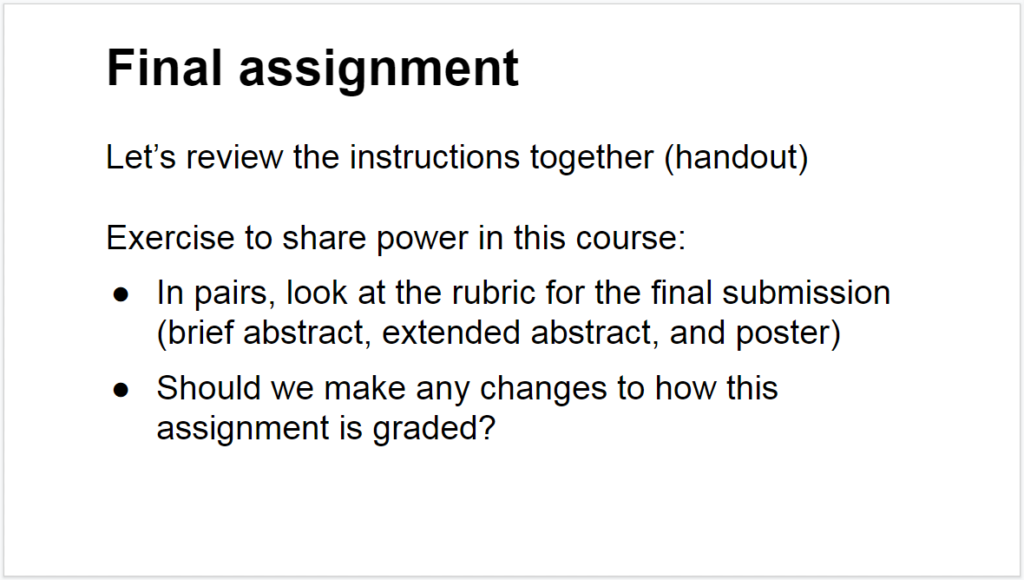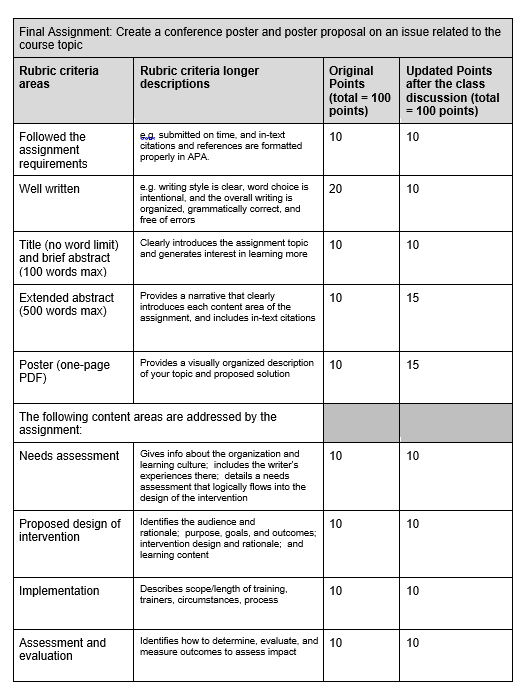Sharing power with students by seeking their input on a grading rubric


Editor’s Note: Matthea Marquart is the Director of Administration for the Online Campus at the Columbia School of Social Work and Elise Verdooner is an Associate with the Columbia School of Social Work. In this blog post, Matthea & Elise share how they sought input from social work students in one of their courses to revise and update an assignment rubric. This practice offers social work educators at all levels the opportunity to bring equity to the classroom.
Introduction: Why did we decide to try sharing power with students around the rubric for our final assignment?
This spring, we worked together to teach a course on Staff Development, Training, and Coaching at Columbia University’s School of Social Work (CSSW). This is an elective course for second-year students in their final semester of our MSW program. Matthea was the instructor and Elise was the Associate (similar to a TA, an Associate at CSSW provides academic support to graduate social work students).
As we were planning the course, Matthea attended a workshop on “Grading, Rubrics, and Feedback for Equity and Inclusion,” which was hosted by Monique M. Jethwani, Director of Faculty Development at CSSW, and led by Amanda M. Jungels and Chandani Patel of Columbia’s Center for Teaching and Learning (CTL). Matthea’s key takeaway from the workshop was to try an activity to increase inclusiveness around grading by giving students the power to amend the rubric for the final assignment, and Elise was willing to give it a try as well. The activity appealed to us because as social workers we believe in creating an inclusive classroom.
Logistics: How did we do this?
In the second week of class, we introduced the final assignment with an in-class activity we described as an “exercise to share power.” First, we had the students go into pairs to discuss and review the instructions and rubric for the final assignment. Afterwards, we asked the class whether there should be changes to how this assignment was graded, keeping the total points at 100. We kept this open-ended to see what the students suggested and were ready to adopt their recommendations. Through group discussion, the students proposed changes to the point values assigned to three of the rubric criteria areas. When a new point value was proposed we discussed the change as a group, asked if everyone thought it was fair, and then agreed to make the changes to the rubric. The main change proposed was to decrease points for the assignment being “well written” by half (from 20 to 10) and to add the subtracted 10 points to the visual presentation of the poster and the extended abstract (each of these areas increasing from 10 to 15).
The whole activity took about 20 minutes: introducing the activity and spending time in pairs took about 10 minutes, and discussing and voting on the changes as a class took less than 10 minutes. Because it was a small class and everyone agreed quickly, the discussion and vote were quick, even with some silent time in which we waited and made space for students to share their thoughts; had there been alternate opinions, this would have taken more time. Then, the following week, we distributed the updated final assignment rubric and reviewed it in class, which took about 2 minutes because there weren’t many questions. Here is the slide with the instructions for this activity:

And here is the rubric for the activity (click on the image to download a copy):
Student perspectives
After the course ended and final grades were submitted, we reached out to two of the students who were active in this activity, to see what they thought. Both agreed to provide feedback:
Kim Levinstein: “Often with assignments you find that the rubric grade distribution has little to do with the amount of time and effort each portion of an assignment requires. We initially noted that “well written” was one of the largest grade points, but felt the most arbitrary, and that sections that required less time were of equal value (the 100 word was worth just as much as the 500 word abstract). To be able to express this and shift the point values accordingly provided a sense of ownership and understanding of not only what our assignment would be, but how we would be evaluated for it. It felt like in this case at least we got (or lost) credit where credit was due.”
Samantha Arthur: “At CSSW the power dynamics that exist between students and instructors in classroom settings are rarely addressed. I appreciated our class being given the space to provide our thoughts about the rubric for the final assignment. This process gave me a concrete example of how students could contribute to their own learning experience. I have never been asked to provide this type of input, so I was initially unsure of how to start. The conversation being had in an open classroom forum truly added to the activity; as the interaction continued I became more confident in sharing my thoughts. Matthea and Elise being receptive to our feedback was an important factor as well.”
Our perspectives
At the end of the course, we also reflected on this power sharing process:
Elise: When Matthea originally told me about this idea to engage students in developing the rubric, I was intrigued and excited to attempt this new style of teaching. I was curious how the students would react and whether they would take this seriously. The students initially seemed apprehensive about proposing changes to the rubric, but after one person suggested a change, others became engaged in the conversation. It was almost like the class gave a collective sigh of relief, taking some of the pressure off composing the “perfect” assignment. This spirit of collaboration seemed to extend into the remainder of the class period for that week. This dialogue also sparked a shift in how I engaged with the students. Whether I was becoming more comfortable with the students after two weeks of class or as a result of this conversation, in subsequent weeks I felt more comfortable approaching the students and chatting with them before and after class.
Matthea: I wasn’t sure how this would work, and was slightly worried that students would ask why we were asking them to do our jobs for us by finalizing the rubric. When we presented the activity to share power, I had the impression that the students hadn’t done this before but that they were cautiously open to giving it a try. I appreciated the students’ feedback, as well as their willingness to speak up; after all, they could have worried that feedback would be taken as criticism of our rubric or of us, so it was brave of them to request changes. Fortunately, the community agreements we created together included “All ideas are welcome,” “Feedback on ideas, not people,” “Don’t yuck my yum,” and “Try to understand before responding,” and these agreements hopefully created an environment in which it was easier to be brave. At first, the students were quiet, then a brave soul tentatively chimed in, and then that broke the ice and the full class participated. In the end, the students’ ideas made a lot of sense, and I thought the rubric was stronger and fairer after we made their changes. The students also asked good questions about the assignment instructions, and I was glad that the activity got them thinking.
Recommendations
Although neither of us had tried this type of activity before, or experienced it as students, it turned out to be something we’d recommend for other instructional teams. For those who are interested in trying this out, here are some thoughts:
- If you have a lot of class time available, consider getting the students involved in drafting the whole rubric (the assignment grading criteria and point values).
- Next time, we may try leaving the point values empty and having the students suggest amounts for each criteria that add up to the total assignment points.
- We might also try doing this more than once during a semester, with more than one assignment, as students may be more willing and able to contribute a second time.
- If you try this, be ready to actually give up decision-making power. If you’re genuinely sharing the power with the students, you will need to be ready to listen to and accept what they propose, even if it’s not what you would have decided.
Do you have a similar power sharing practice in your courses? We would like to hear from you about what you do to promote equity with grading criteria and professional feedback. You can provide your ideas in the comments below.
How to cite this blog post:
Marquart, M. & Verdooner, E. (2019, June 19). Sharing power with students by seeking their input on a grading rubric [Blog Post]. Retrieved from: https://laureliversonhitchcock.org/2019/06/19/sharing-power-with-students-by-seeking-their-input-on-a-grading-rubric/



